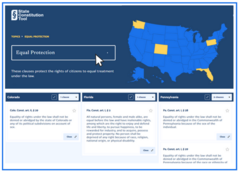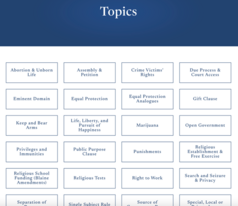
A New Tool Makes Comparing State Constitutions Easier
Scholars, practitioners, and judges can quickly see how constitutional provisions differ or overlap with a resource from the nonprofit American Juris Link.
As we know from Justice William Brennan’s clarion calls to state courts to independently interpret their state constitutions, decisions in such areas as the rights of criminal defendants, educational guarantees, and constraints on eminent domain often build upon one another from state to state. And state courts often look to jurisprudence from other states to determine how to interpret similar state constitutional provisions.
But how can judges, academics, and practitioners understand which provisions are common to multiple state constitutions, and how they differ or overlap? Until now, such research was a slog. A new tool aims to simplify comparing state constitutions for scholars, practitioners, and judges.
StateConstitutionTool.org is a user-friendly resource to compare state constitutions. It provides a selection of ready-made topics, ranging from search and seizure to abortion and gift clauses, that can be tailored for any range of states. Search results are produced in side-by-side comparisons, making research and analysis effortless. To make comparisons even easier, it highlights similar language so users can instantly spot similarities and differences. Searches can encompass all 50 states or any subset.

Prominent members of the legal community have provided feedback on the tool. Eugene Volokh of The Volokh Conspiracy and Matthew Segal, co-director of the ACLU’s State Supreme Court Initiative have both said they found it helpful. Segal even called it “extremely cool.”
Arizona Supreme Court Justice Clint Bolick asked a law clerk to find out how many states have express separation-of-powers provisions, and told us it took longer for him to convey the assignment than for his clerk, using the tool, to complete it. And Alabama Supreme Court Justice Jay Mitchell, in a concurring opinion rejecting interpretation of the state constitution in “lockstep” with its federal counterpart, referred to it as “a useful tool to compare state and federal constitutional provisions.”
The tool has many uses. Judges can readily determine which other states have state constitutional language that is similar (or different) to a clause they are applying in a case. Lawyers facing novel issues of state constitutional interpretation can quickly identify states that may have confronted related issues. Public interest lawyers, in particular, can identify potential target states for litigation based on favorable constitutional language. Legal strategists can track trends and identify gaps in state constitutions. Language that has been favorably applied can provide a template for constitutional change in other states.
For scholars, the tool offers opportunities for research — which can in turn support future litigation. The Institute for Justice’s Anthony Sanders, for instance, recently published a book on “baby Ninth Amendments” in state constitutions that protect liberties beyond those specifically enumerated. Had the tool be available when he was writing it, the research tab devoted to unenumerated rights would have effectively amassed dozens of hours of research in seconds.

Indeed, given the plethora of understudied provisions in state constitutions, the tool’s research categories themselves may alert practitioners to ancillary legal theories they hadn’t previously considered.
Give the tool a try. We think you’ll stay longer than you expected, spotting patterns and trends in clauses among different states, and that you’ll quickly integrate it into your own practice.
Carrie Ann Donnell is a lawyer in Arizona and founder of American Juris Link, a nonprofit organization that helps pro bono litigators advance the rule of law.
Suggested Citation: Carrie Ann Donnell, A New Tool Enables Comparing State Constitutions, Sᴛᴀᴛᴇ Cᴏᴜʀᴛ Rᴇᴘᴏʀᴛ(Jul. 30, 2025), https://statecourtreport.org/our-work/analysis-opinion/new-tool-enables-comparing-state-constitutions



Related Commentary
2025’s Most Significant State Constitutional Cases
Leading legal thinkers weighed in on the state constitutional rulings our readers should know about from this past year.
Bush v. Gore Introduced a Fringe Theory that Threatened Elections Decades Later
The “independent state legislature theory,” shut down in 2023 by the U.S. Supreme Court, would have robbed state courts of the power to review state laws related to federal elections.
State Judges Target the U.S. Supreme Court
A justice in Washington concurred in a recent opinion but dissented “from the racism embedded in the federal case law that applies to this dispute.”
The Extra Hurdle in State Courts to Prove a Statute Violates the U.S. Constitution
Many states require a litigant challenging a statute as violating the U.S. Constitution to prove the statute is unconstitutional “beyond a reasonable doubt.”